Important
Traducerea este un efort al comunității, la care puteți să vă alăturați. În prezent, această pagină este tradusă 34.62%.
14.2. Lesson: Georeferencing a Map
O activitate silvică obișnuită constă în actualizarea informațiilor pentru zonele forestiere. Este posibil ca informațiile anterioare pentru acea zonă să aibă o vechime de mai mulți ani, să fi fost colectate în mod analogic (adică, pe hârtie) sau poate că au fost digitizate, dar tot ce aveți reprezintă versiunea pe hârtie a datelor inventarului respectiv.
Cel mai probabil, v-ați dori să utilizați aceste informații în GIS, de exemplu, pentru a le compara mai târziu cu inventarele ulterioare. Acest lucru presupune că va trebui să digitizați manual informațiile, cu ajutorul softului GIS. Dar, înainte de a începe digitizarea, trebuie făcuți pași importanți, cum ar fi scanarea și georeferențierea hărții de hârtie.
Scopul acestei lecții: De a afla cum să utilizați instrumentul de Georeferențiere din QGIS.
14.2.1. ★☆☆ Scan the map
Prima activitate constă în scanarea hărții. Dacă harta dvs. este prea mare, atunci o puteți scana pe porțiuni, dar rețineți că pentru fiecare parte va trebui să reluați acțiunile de preprocesare și georeferențiere. Din acest motiv, este recomandabil să împărțiți harta în cel mai mic număr de porțiuni posibile.
If you are going to use a different map that the one provided with this manual, use your own scanner to scan the map as an image file, a resolution of 300 DPI will do. If your map has colors, scan the image in color so that you can later use those colors to separate information from your map into different layers (for ex., forest stands, contour lines, roads…).
For this exercise you will use a previously scanned map, you can find it as
rautjarvi_map.tif in the data folder exercise_data/forestry
14.2.2. ★☆☆ Follow Along: Georeferencing the scanned map
Open QGIS and set the project’s CRS to
EPSG:3067 - ETRS89 / TM35FIN(E,N)in , which is the currently used CRS in Finland.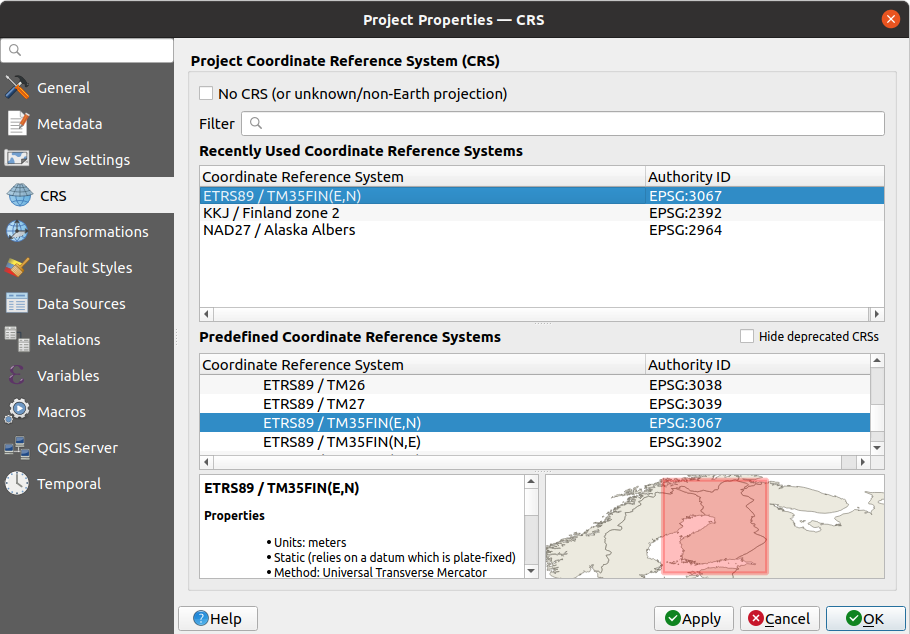
Save the QGIS project as
map_digitizing.qgs.
You will use the georeferencing tool from QGIS named Georeferencer. To georeference the map:
-
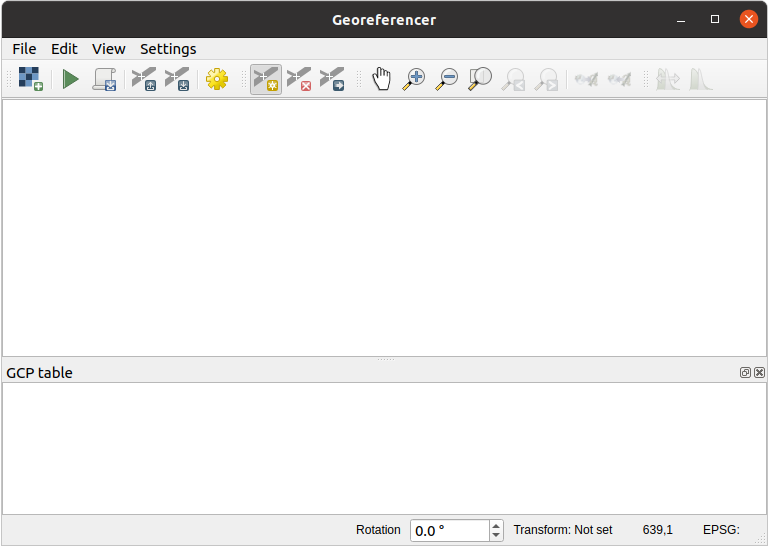
Add the map image file,
rautjarvi_map.tif, as the image to georeference, .Clic pe OK
Ulterior ar trebui să definiți setările de transformare pentru georeferențierea hărții:
Deschideți .
Set the Transformation type to
Linearand the Resampling method toNearest neighbour.Press the
 Select CRS button next to
the Target SRS option and select the
Select CRS button next to
the Target SRS option and select the EPSG:2392 - KKJ / Finland zone 2CRS; it is the CRS that was used in Finland back in 1994 when this map was created.Click the icon next to the Output raster box, go to the folder and create the folder
exercise_data\forestry\digitizingand name the file asrautjarvi_georef.tif.Leave the rest of parameters as default.
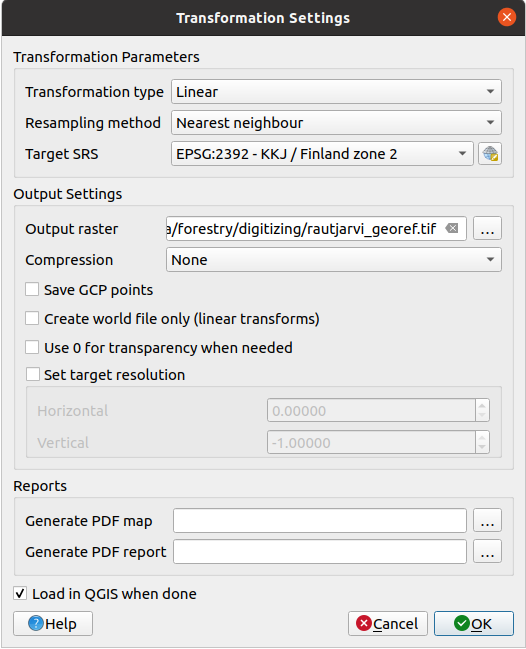
Clic pe OK
The map contains several cross-hairs marking the coordinates in the map, we will use those to georeference this image. You can use the zooming and panning tools as you usually do in QGIS to inspect the image in the Georeferencer’s window.
Zoom in to the left lower corner of the map and note that there is a cross-hair with a coordinate pair, X and Y, that as mentioned before are in
KKJ / Finland zone 2CRS. You will use this point as the first ground control point for the georeferencing your map.Selectați instrumentul Adăugare punct, apoi faceți clic pe intersecția firelor reticulare (deplasați și măriți după nevoie).
In the Enter map coordinates dialogue write the coordinates that appear in the map (X: 2557000 and Y: 6786000) and their CRS (
EPSG:2392 - KKJ / Finland zone 2)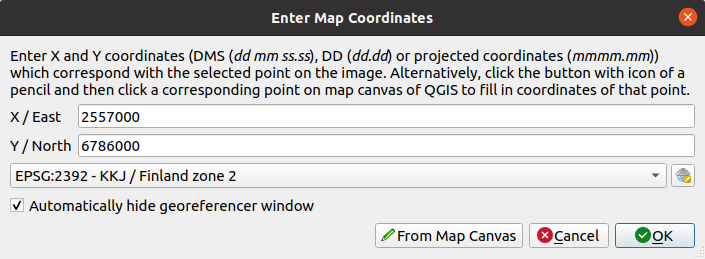
Clic pe OK
Prima coordonată de georeferențiat deja este gata.
Look for other black cross-hairs in the image, they are separated 1000 meters from each other both in North and East direction. You should be able to calculate the coordinates of those points in relation to the first one.
Zoom out in the image and move to the right or the top until you find other cross-hair, and estimate how many kilometres you have moved. Try to get ground control points as far from each other as possible.
Digitize at least three more ground control points in the same way you did the first one. You should end up with something similar to this:
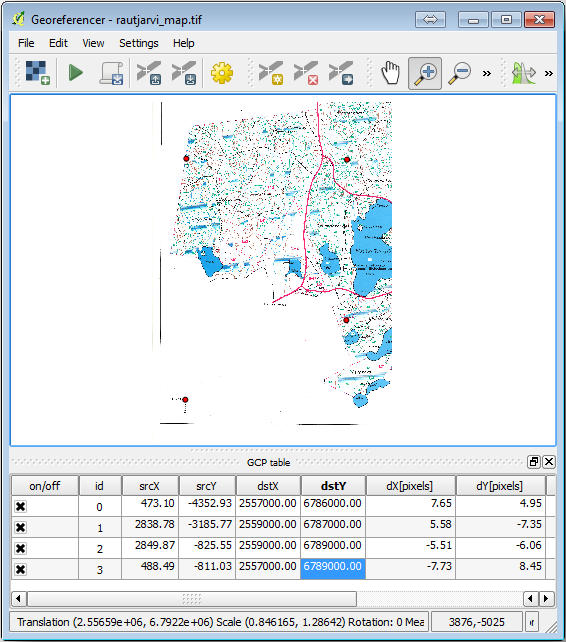
With already three digitized ground control points you will be able to see the georeferencing error as a red line coming out of the points. The error in pixels can be seen also in the GCP table in the dX[pixels] and dY[pixels] columns. The error in pixels should not be higher than 10 pixels. If it is, you should review the points you have digitized and the coordinates you have entered to find what the problem is. You can use the image above as a guide.
Once you are happy with your control points, you can save them for later use:
Go to .
In the folder
exercise_data\forestry\digitizing, name the filerautjarvi_map.tif.points.
Finally, georeference your map:
Go to .
Note that you named the file already as
rautjarvi_georef.tifwhen you edited the Georeferencer settings.Now you can see the map in QGIS project as a georeferenced raster. Note that the raster seems to be slightly rotated, but that is simply because the data is in
KKJ / Finland zone 2and your project is inETRS89 / TM35FIN(E,N).To check that your data is properly georeferenced, you can
Open the aerial image in the
exercise_data\forestryfolder, namedrautjarvi_aerial.tif.Your map and this image should match quite well: set the map transparency to 50% and compare it to the aerial image.
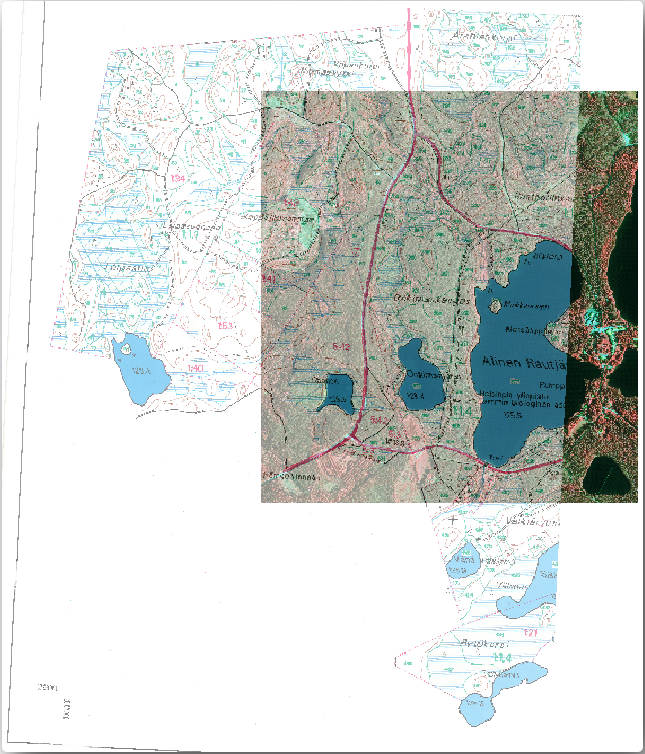
Salvați modificările proiectului QGIS, apoi veți continua din acest punct cu lecția următoare.
14.2.3. În concluzie
You have now georeferenced a paper map, making it possible to use it as a map layer in QGIS.
14.2.4. Ce urmează?
In the next lesson, you will digitize the forest stands in your map as polygons and add the inventory data to them.

